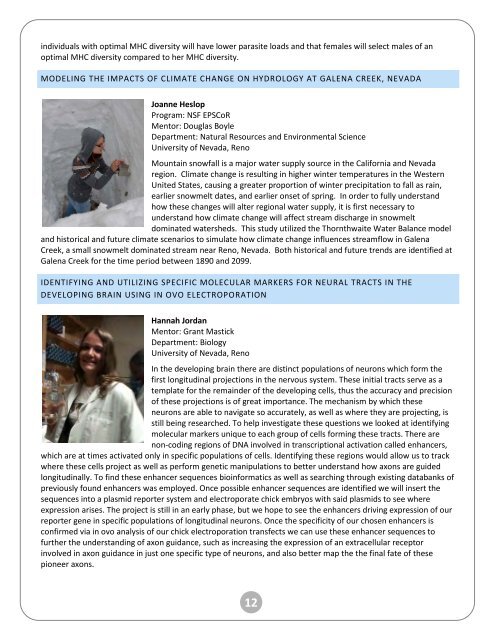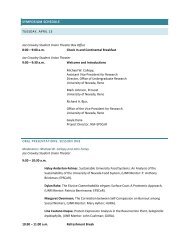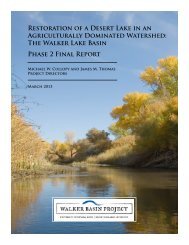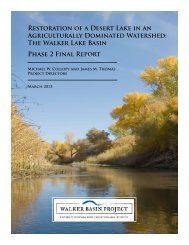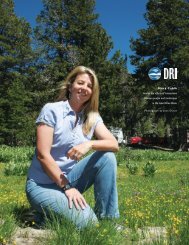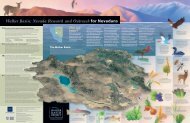Student Research Programs - Office of Undergraduate and ...
Student Research Programs - Office of Undergraduate and ...
Student Research Programs - Office of Undergraduate and ...
Create successful ePaper yourself
Turn your PDF publications into a flip-book with our unique Google optimized e-Paper software.
individuals with optimal MHC diversity will have lower parasite loads <strong>and</strong> that females will select males <strong>of</strong> an<br />
optimal MHC diversity compared to her MHC diversity.<br />
MODELING THE IMPACTS OF CLIMATE CHANGE ON HYDROLOGY AT GALENA CREEK, NEVADA<br />
Joanne Heslop<br />
Program: NSF EPSCoR<br />
Mentor: Douglas Boyle<br />
Department: Natural Resources <strong>and</strong> Environmental Science<br />
University <strong>of</strong> Nevada, Reno<br />
Mountain snowfall is a major water supply source in the California <strong>and</strong> Nevada<br />
region. Climate change is resulting in higher winter temperatures in the Western<br />
United States, causing a greater proportion <strong>of</strong> winter precipitation to fall as rain,<br />
earlier snowmelt dates, <strong>and</strong> earlier onset <strong>of</strong> spring. In order to fully underst<strong>and</strong><br />
how these changes will alter regional water supply, it is first necessary to<br />
underst<strong>and</strong> how climate change will affect stream discharge in snowmelt<br />
dominated watersheds. This study utilized the Thornthwaite Water Balance model<br />
<strong>and</strong> historical <strong>and</strong> future climate scenarios to simulate how climate change influences streamflow in Galena<br />
Creek, a small snowmelt dominated stream near Reno, Nevada. Both historical <strong>and</strong> future trends are identified at<br />
Galena Creek for the time period between 1890 <strong>and</strong> 2099.<br />
IDENTIFYING AND UTILIZING SPECIFIC MOLECULAR MARKERS FOR NEURAL TRACTS IN THE<br />
DEVELOPING BRAIN USING IN OVO ELECTROPORATION<br />
Hannah Jordan<br />
Mentor: Grant Mastick<br />
Department: Biology<br />
University <strong>of</strong> Nevada, Reno<br />
In the developing brain there are distinct populations <strong>of</strong> neurons which form the<br />
first longitudinal projections in the nervous system. These initial tracts serve as a<br />
template for the remainder <strong>of</strong> the developing cells, thus the accuracy <strong>and</strong> precision<br />
<strong>of</strong> these projections is <strong>of</strong> great importance. The mechanism by which these<br />
neurons are able to navigate so accurately, as well as where they are projecting, is<br />
still being researched. To help investigate these questions we looked at identifying<br />
molecular markers unique to each group <strong>of</strong> cells forming these tracts. There are<br />
non-coding regions <strong>of</strong> DNA involved in transcriptional activation called enhancers,<br />
which are at times activated only in specific populations <strong>of</strong> cells. Identifying these regions would allow us to track<br />
where these cells project as well as perform genetic manipulations to better underst<strong>and</strong> how axons are guided<br />
longitudinally. To find these enhancer sequences bioinformatics as well as searching through existing databanks <strong>of</strong><br />
previously found enhancers was employed. Once possible enhancer sequences are identified we will insert the<br />
sequences into a plasmid reporter system <strong>and</strong> electroporate chick embryos with said plasmids to see where<br />
expression arises. The project is still in an early phase, but we hope to see the enhancers driving expression <strong>of</strong> our<br />
reporter gene in specific populations <strong>of</strong> longitudinal neurons. Once the specificity <strong>of</strong> our chosen enhancers is<br />
confirmed via in ovo analysis <strong>of</strong> our chick electroporation transfects we can use these enhancer sequences to<br />
further the underst<strong>and</strong>ing <strong>of</strong> axon guidance, such as increasing the expression <strong>of</strong> an extracellular receptor<br />
involved in axon guidance in just one specific type <strong>of</strong> neurons, <strong>and</strong> also better map the the final fate <strong>of</strong> these<br />
pioneer axons.<br />
12


